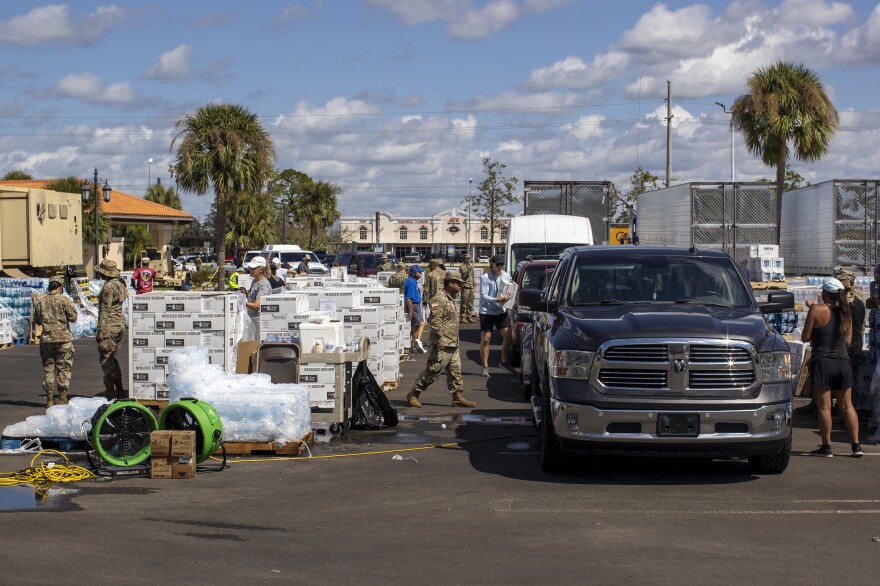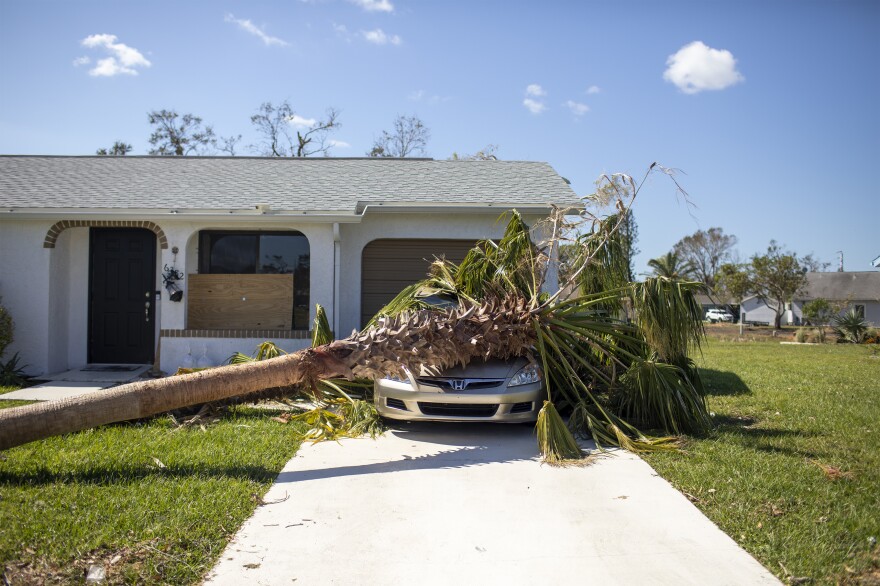NORTH PORT, Fla. — One week after fierce winds and rising water trapped Alva Sulaty and George Perez in their home in the Country Club Ridge neighborhood of North Port, Fla., the couple's property is finally dry enough to start cleaning up the overwhelming mess left by Hurricane Ian.
Ruined furniture is piled high at the curb as they sort through sodden belongings, discarding items too waterlogged to save.
"You see that waterline?" asks Perez, pointing to a dirty mark two feet up the garage wall. "That's how high the water was."
Their home, he says, isn't even in a flood zone.

Inside, the ceiling has partially collapsed. Sulaty opens a closet door to reveal gray drifts of silt still covering the floor.
"So you clean one mess up, and then as you start looking and you find another one, and you find another one, and you find another one," she says.
Sulaty says she's lost count of how many times she's cleaned these floors since returning.
Her daughter, Tina Krasinski, handles the more heavy-duty task of sawing through ruined drywall. The morning after the hurricane, she paddled a canoe down the street to rescue her family from this house.
Now, she's back inside, pulling chunks of wet insulation out of a bedroom wall and tossing them out a broken window, into a growing heap of soggy pink shreds. She learned how to do most of this from watching YouTube.

"There's a lot of mold," Krasinski explains. "We're going to try, until insurance comes through, I guess, to make it as livable as possible."
Blue tarps, downed trees, and mountains of soaked furniture and scrap metal are a common sight in North Port, where residents were hit hard by Hurricane Ian only to suffer even more flooding days later, as rivers and canals overflowed with rain runoff.
The sounds of chainsaws and hammering echo down the block as Michelle King cleans up debris that blew into her home through a broken window. What's left of her carport sits crumpled in the yard of her duplex.
"Inside the house, it's like normal," King says, "When I step outside, it's like a war zone. I just want to cry."

King has been through a lot.
Before the storm, she evacuated with her family to Lamarque Elementary School, where her 6-year-old son, Hunter, attends kindergarten. The school was the region's medical shelter during the hurricane, but Ian's high winds ripped the roof off the cafeteria, and the shelter flooded.
"Power started going off with a generator," King remembers. "My husband almost died twice there, because he's on oxygen. So there was no toilets, no food, no water, no medicine, no roof, no patience!"
She says the nerves of people in the shelter were so frazzled that an elderly woman threatened to punch King when Hunter got rowdy. Once Hurricane Ian passed, King and her family were evacuated by bus — in rising floodwaters — to a shelter in Sarasota, where they stayed for five days.

She doesn't know when Hunter will be able to return to his school, because it was so damaged. Instead, Hunter spent the morning next door at his great-aunt's house, decorating the still-soggy front yard with plastic Halloween tombstones and toy skeletons.
The family hopes the spooky scene outside will give the neighborhood a sense of normalcy, and help Hunter forget the real-life scare of the hurricane. But his mom says she won't forget any time soon.
"It's really hard," King says. "It's like I'm in a movie, but I can't snap out if it. I can't press stop or pause and be like, OK, I'm back to normal."
She knows it's going to be a long while before things are back to normal.
Copyright 2023 NPR. To see more, visit https://www.npr.org.







